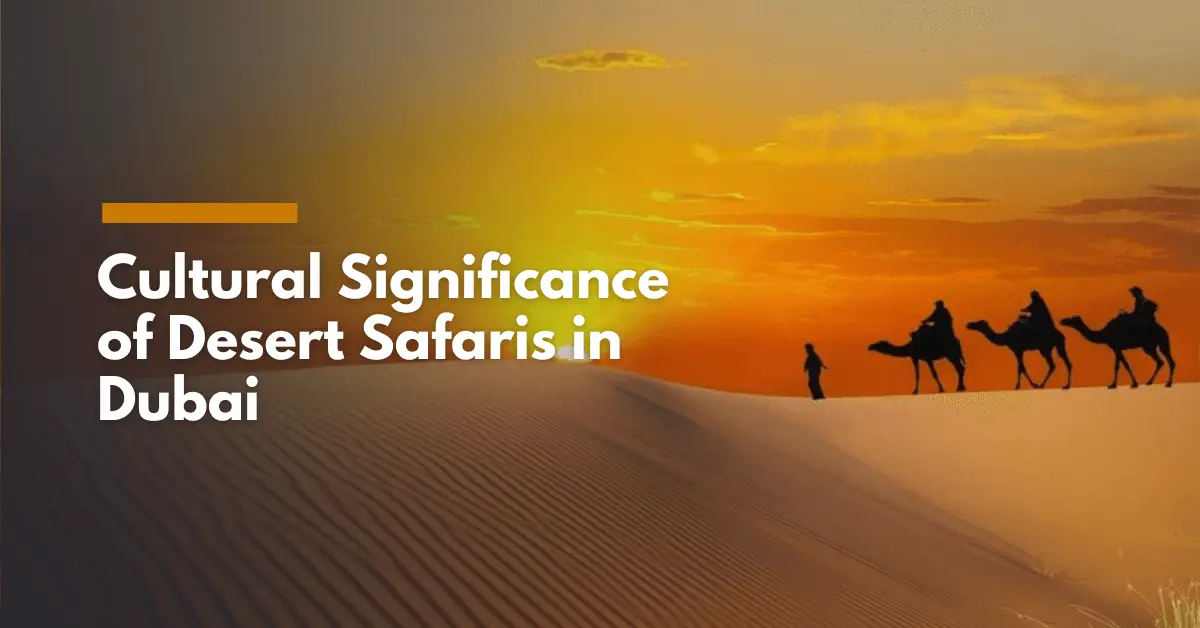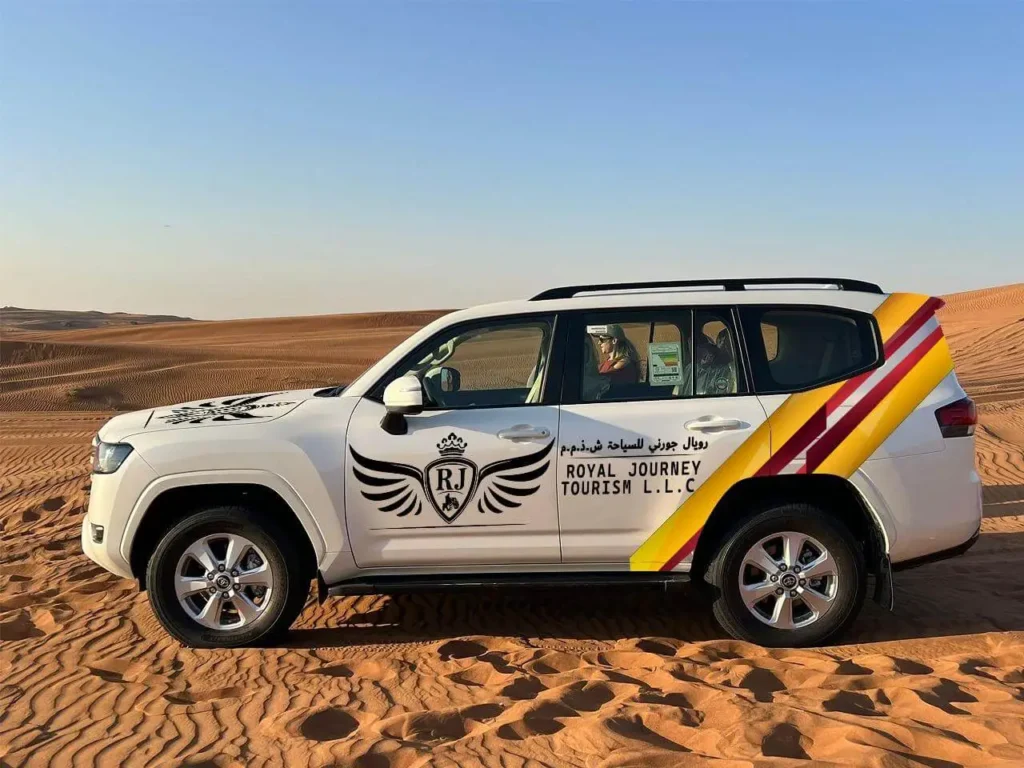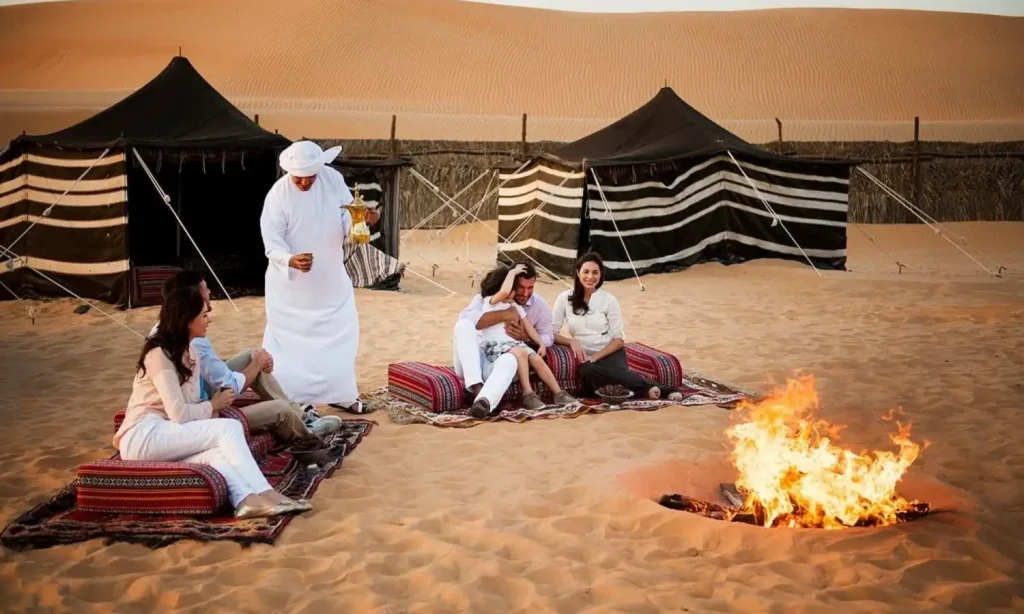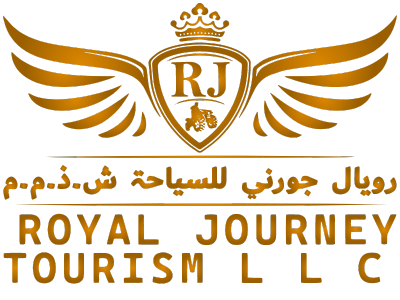
Discover the Cultural Significance of Desert Safaris in Dubai
Experiencing a desert safari in Dubai is not just about the thrilling rides and stunning landscapes; it’s a journey into the cultural significance of desert safari and the rich heritage and traditions of the Bedouin people. This unique adventure offers visitors an opportunity to engage with the timeless nomadic way of life that has thrived in the Arabian desert for centuries. Each desert safari experience is a blend of exhilarating activities, cultural immersion, and a chance to appreciate the delicate desert ecosystem that defines this remarkable region.
What is a Desert Safari Experience in Dubai?

A desert safari in Dubai is a multifaceted adventure that allows tourists to explore the breathtaking beauty of the Dubai desert. This experience typically begins with a thrilling 4×4 ride over the majestic dunes, where guests can enjoy the exhilarating sensation of dune bashing. As the sun sets, the landscape transforms, offering an unforgettable view that enhances the cultural significance of the desert safari. The journey into the heart of the desert is often complemented by traditional Bedouin hospitality, making it a seamless blend of adventure and cultural exploration.
The allure of a Dubai desert safari lies not only in the adrenaline-fueled activities but also in the rich tapestry of experiences woven throughout the journey. Visitors can expect to encounter traditional Bedouin camps adorned with tents, where they can partake in activities like henna painting and savor authentic Arabic cuisine. The desert ambiance is truly unique, combining the natural beauty of the desert landscape with the warmth and hospitality of the local culture. This deeply immersive experience allows travelers to appreciate both the stunning environment and the historical context of the Bedouin way of life.
What Can You Expect from a Dubai Desert Safari?
During a Dubai desert safari, travelers can expect a plethora of exciting and culturally enriching experiences. The journey typically kicks off with a thrilling ride across the golden dunes in a sturdy 4×4 vehicle, providing a taste of the adrenaline that awaits. As the adventure unfolds, guests can witness the stunning sunset over the Arabian desert, a sight that perfectly encapsulates the beauty of the desert landscape. The experience is designed to be both exhilarating and educational, offering insights into the rich history and traditions of the Dubai desert.
In addition to the breathtaking views, a desert safari often includes opportunities for cultural immersion through various traditional activities. Visitors can engage in camel rides, offering a glimpse into the nomadic lifestyle of the Bedouin people, or enjoy a relaxing evening at a desert camp, where they can experience the warm hospitality characteristic of Bedouin culture. The combination of thrilling activities and cultural experiences makes the Dubai desert safari a well-rounded adventure that appeals to a wide range of tourists seeking both excitement and knowledge about the region’s heritage.
What Activities Are Included in a Desert Safari Package?
A typical desert safari package in Dubai includes a diverse range of activities that cater to thrill-seekers and culture enthusiasts alike. Most packages feature exhilarating dune bashing sessions, where participants can feel the rush of speed as they navigate the vast dunes. Following this adventure, guests often enjoy a camel ride, allowing them to embrace the traditional mode of transport that has been integral to Bedouin culture for centuries. These activities not only provide excitement but also offer a deeper understanding of life in the desert.
Moreover, evening desert safaris usually incorporate cultural performances, such as belly dance shows, showcasing the rich artistic traditions of the region. Visitors can also indulge in traditional Arabic cuisine served in a Bedouin camp, enhancing their connection to the local culture. Additional activities like henna painting and falconry demonstrations further enrich the experience, allowing tourists to engage with the customs and practices that define the Bedouin way of life. This multifaceted approach ensures that each desert safari package is a memorable blend of thrill, culture, and historical significance.
How to Choose the Best Desert Safari in Dubai?

Choosing the best desert safari in Dubai involves considering several factors to ensure an unforgettable experience. First and foremost, travelers should evaluate the type of activities included in the safari package. Some may prioritize thrilling dune bashing, while others might seek a more culturally focused experience with traditional Bedouin camps. Reading reviews and seeking recommendations can guide visitors toward the most reputable operators, ensuring safety and quality during their adventure in the desert.
Additionally, the time of day can significantly influence the desert safari experience. Evening desert safaris, for example, offer stunning sunset views and vibrant cultural entertainment, while morning safaris provide a unique opportunity to explore the cooler desert landscape. Travelers should also consider group sizes, as smaller groups often allow for a more personalized experience. Ultimately, aligning personal preferences with available options will help ensure that visitors select the best desert safari in Dubai that meets their interests and expectations.
How Do Desert Safaris Reflect Bedouin Culture?

Desert safaris serve as a vibrant reflection of Bedouin culture, showcasing the traditions and hospitality that define the Bedouin way of life. The Bedouins, known for their nomadic lifestyle, have a rich cultural heritage that is expressed in various aspects of the desert safari experience. From the moment guests arrive at the desert camp, they are welcomed with traditional Arabic hospitality, which includes offerings of dates and Arabic coffee, symbolizing the deep-rooted customs of welcoming guests in Bedouin society.
As visitors engage in activities like camel riding and henna painting, they gain firsthand insights into the Bedouin’s historical connection to the desert environment. Each activity is carefully curated to highlight the skills and traditions that have been passed down through generations, thereby fostering a greater appreciation for the Bedouin culture. By participating in these experiences, tourists not only enjoy the adventure but also contribute to the preservation of these traditions, making the desert safari a vital part of cultural exchange and understanding in Dubai.
What Are the Traditions of the Dubai Desert?
The traditions of the Dubai desert are deeply intertwined with the Bedouin culture, reflecting a lifestyle that has evolved over centuries. One of the most significant traditions is the art of falconry, which is not only a sport but also a symbol of status and pride among Bedouins. The practice showcases the unique bond between humans and falcons, highlighting the importance of these birds in Bedouin life and their role in hunting. Desert safaris often incorporate falconry displays, allowing guests to witness this ancient tradition firsthand.
Another key aspect of Dubai desert traditions is the significance of storytelling and oral history among the Bedouins. Tales of bravery, adventure, and the desert’s natural beauty are often shared around evening campfires, fostering a sense of community and connection to the past. These stories not only entertain but also serve to educate visitors about the rich history and cultural significance of the desert. Through such narratives, the essence of Bedouin life is preserved, making the traditions of the Dubai desert an essential part of the safari experience.
How is Bedouin Hospitality Showcased in Desert Camps?
Bedouin hospitality is renowned for its warmth and generosity, and desert camps are the perfect stage for showcasing these cultural values. Upon arrival at a desert camp, guests are greeted with traditional Arabic coffee and dates, a customary gesture that reflects the deep-rooted practice of welcoming visitors. This initial interaction sets the tone for the entire desert safari experience, emphasizing the importance of hospitality in Bedouin culture. Guests are often invited to relax in beautifully decorated tents, adorned with traditional fabrics and furnishings that create an inviting atmosphere.
Throughout the evening, the essence of Bedouin hospitality continues to shine through as guests are treated to a variety of cultural activities. From enjoying a sumptuous buffet featuring traditional Arabic dishes to watching captivating performances such as belly dancing, every aspect of the desert camp experience is designed to make visitors feel valued and engaged. Additionally, the opportunity to participate in activities like henna painting or falconry demonstrations further emphasizes the welcoming nature of Bedouin culture, allowing guests to immerse themselves in the rich traditions and practices that define the desert way of life.
What Role Do Traditional Bedouin Activities Play in Cultural Immersion?
Traditional Bedouin activities play a crucial role in cultural immersion during desert safaris, allowing visitors to engage with the customs and practices that have shaped Bedouin life for centuries. Activities like camel riding in Dubai provide a unique opportunity for tourists to connect with the desert environment while experiencing a mode of transport that has been integral to the Bedouin way of life. Through these interactions, guests gain a deeper appreciation for the rich history and significance of camels in Bedouin culture, highlighting the bond between people and nature in the harsh desert landscape.
Another key traditional activity is falconry, where guests can witness the skill and artistry involved in training these magnificent birds. This ancient practice not only demonstrates the Bedouins’ deep connection to the desert ecosystem but also serves as a means of cultural exchange, as visitors learn about the significance of falcons in Bedouin heritage. By participating in such activities, tourists are not merely observers; they become active participants in a living cultural narrative, fostering mutual understanding and respect for the rich traditions that define the desert experience.
What Are the Interesting Facts About Dubai’s Desert Safari?

Dubai’s desert safari is steeped in interesting facts that enhance the overall experience for visitors. One notable aspect is the history of the Dubai desert safari, which has evolved from a practical means of transportation and exploration to a major tourism attraction. This shift reflects the region’s transformation, where the once nomadic lifestyle has adapted to the modern world while preserving its cultural roots. Understanding this history adds depth to the desert safari experience, allowing guests to appreciate the journey from past to present in the context of Bedouin life.
Another intriguing fact is the unique geological features of the Arabian desert, which hosts a variety of dunes shaped by the wind over centuries. Each dune has its distinct character and allure, making dune bashing an exhilarating activity as drivers navigate these natural formations. The desert’s diverse ecosystem is also a point of interest, as it supports a range of flora and fauna that have adapted to survive in the harsh climate. These fascinating facts enhance visitors’ understanding of the Dubai desert, enriching their cultural experience while highlighting the natural beauty and heritage of the region.
What Historical Aspects Influence Today’s Desert Safari?
The historical aspects of the Dubai desert significantly influence today’s desert safari, providing context and depth to the experience. The Bedouin tribes, who have inhabited the Arabian desert for centuries, shaped the region’s cultural landscape through their nomadic lifestyle and deep connection to the environment. Understanding this history allows visitors to appreciate the evolution of desert safaris, which have transitioned from practical journeys through the desert to vibrant cultural experiences that celebrate Bedouin heritage.
Moreover, the influence of trade routes and the discovery of oil has transformed Dubai into a global hub for tourism, leading to the development of modern desert safari experiences. These historical milestones have shaped the way desert safaris are marketed and presented, blending traditional elements with contemporary attractions. By recognizing these historical influences, tourists can better understand the significance of their desert safari, enhancing their overall appreciation for the rich cultural and historical tapestry that defines the Dubai desert.
What Are Some Unique Experiences in the Arabian Desert?
The Arabian desert offers a wealth of unique experiences that elevate desert safaris to unforgettable adventures. One standout experience is the opportunity to witness the breathtaking dawn or dusk in the desert, where the sun casts a magical glow over the dunes. This natural beauty provides an awe-inspiring backdrop for photography and reflection, allowing visitors to connect with the serene desert landscape. Additionally, many desert safaris include the chance to camp overnight in the heart of the desert, providing an immersive experience that allows guests to stargaze under the clear night sky.
Another unique experience is the traditional Arabic entertainment often featured during evening desert safaris. Visitors can enjoy captivating performances, such as belly dancing and Tanoura shows, which highlight the rich artistic traditions of the region. Furthermore, engaging in activities like henna painting or learning about falconry adds another layer of cultural immersion to the experience. These unique offerings ensure that a desert safari in Dubai is not just an adventure but also an enriching journey through the heritage and beauty of the Arabian desert.
How Is Falconry Integrated into Desert Safari Adventures?
Falconry is an integral part of desert safari adventures, deeply rooted in the traditions of Bedouin culture. This ancient practice showcases the bond between humans and falcons, highlighting its significance in hunting and social status within Bedouin society. During desert safaris, guests have the opportunity to witness live falconry demonstrations, where skilled falconers display the intricate techniques used to train these majestic birds. This captivating experience not only entertains but also educates visitors about the historical importance of falconry in the desert environment.
Moreover, many desert safari packages include the chance for guests to interact with falcons, allowing them to hold the birds and learn about their care and training. This hands-on experience fosters a deeper appreciation for the art of falconry and its role in Bedouin culture. By incorporating falconry into desert safaris, operators provide a unique glimpse into the traditions that have shaped the region for generations, ensuring that visitors leave with a richer understanding of the cultural significance behind this fascinating practice.
What Makes the Dubai Desert Ecosystem Unique?
The Dubai desert ecosystem is a unique and delicate environment that plays a crucial role in supporting local wildlife. The combination of harsh desert climate and diverse geological features creates a habitat for various species, from insects and reptiles to mammals and birds. Each organism has adapted to thrive in this challenging landscape, showcasing the resilience of life in the desert. Desert safaris offer visitors a chance to explore this ecosystem, highlighting the importance of conservation and awareness of the natural world.
Furthermore, the Dubai desert is home to several protected areas, including the Dubai Desert Conservation Reserve, which aims to preserve the region’s flora and fauna. Travelers can learn about the efforts being made to protect endangered species, such as the Arabian oryx, and understand how desert safaris can contribute to conservation initiatives. By appreciating the unique aspects of the Dubai desert ecosystem, visitors are encouraged to engage in sustainable tourism practices that respect and protect the delicate balance of life in this remarkable environment.
How Does the Desert Environment Support Local Wildlife?
The desert environment supports local wildlife through a variety of adaptations that enable survival in the harsh climate. Many species have developed unique behaviors and physical characteristics that allow them to thrive in the extreme heat and limited water supply. For instance, the sand gazelle and Arabian oryx are known for their ability to go long periods without water, relying on the moisture found in their food. The ecosystem is also characterized by a rich diversity of plant life, including drought-resistant shrubs and grasses that provide shelter and sustenance for various animals.
Moreover, the interconnectedness of the desert ecosystem plays a vital role in maintaining biodiversity. Predators and prey coexist in a delicate balance, contributing to the overall health of the environment. Desert safaris often incorporate educational elements that highlight these relationships, helping visitors understand the significance of preserving local wildlife and their habitats. By showcasing the adaptations and dynamics of desert life, the Dubai desert experience fosters a greater appreciation for the unique challenges faced by wildlife in this remarkable ecosystem.
What Are the Challenges of the Harsh Desert Climate?
The harsh desert climate presents numerous challenges for both wildlife and human inhabitants alike. Extreme temperatures can reach highs of over 50 degrees Celsius during the day, making survival difficult for many species. Additionally, the lack of consistent water sources forces animals to rely on limited resources, leading to competition among species for survival. This climate also poses challenges for those looking to explore the desert, as conditions can change rapidly, requiring knowledge and preparation to navigate safely.
For desert safari operators, these challenges emphasize the importance of sustainable practices that respect the fragile environment. Educating visitors about the realities of desert life allows for a more profound understanding of the ecosystem’s challenges and the necessity of conservation efforts. By highlighting the difficulties posed by the climate, desert safaris can inspire tourists to engage in responsible tourism that prioritizes ecological preservation and supports initiatives aimed at protecting the delicate desert environment.
How Do Desert Safaris Promote Awareness of the Delicate Ecosystem?
Desert safaris serve as a vital platform for promoting awareness of the delicate ecosystem found in the Dubai desert. By incorporating educational elements into the safari experience, operators help visitors understand the intricate relationships that exist within the desert environment. Through guided tours and informative sessions, guests can learn about the various species that inhabit the area, the adaptations they have developed, and the challenges they face due to climate change and human activity. This knowledge fosters a sense of responsibility and encourages visitors to appreciate the importance of conservation efforts.
Furthermore, many desert safaris actively contribute to environmental initiatives, such as reforestation projects and wildlife conservation programs. By participating in these efforts, tourists can directly engage with the preservation of the desert ecosystem, creating a lasting impact on the region. The combination of adventure and education makes desert safaris a powerful tool for raising awareness about the unique challenges facing the Dubai desert, ultimately encouraging a more sustainable approach to tourism that respects and protects this fragile environment.
What Are the Best Desert Safari Activities for Thrill Seekers?

For thrill-seekers, desert safaris in Dubai offer an array of exhilarating activities that cater to adrenaline junkies. One of the most popular experiences is dune bashing, where skilled drivers take guests on an exhilarating ride across the undulating dunes in a powerful 4×4 vehicle. The thrill of navigating steep slopes and sharp turns provides an unforgettable rush that is unmatched in other adventure sports. This exhilarating activity is a highlight for many tourists and captures the essence of excitement found in the Dubai desert.
In addition to dune bashing, another must-try activity for thrill seekers is sandboarding. Similar to snowboarding, participants can glide down the smooth slopes of the dunes, adding an extra layer of excitement to the desert adventure. For those looking for an even more unique experience, hot air balloon rides offer a breathtaking aerial view of the desert landscape, combining thrill with stunning visual beauty. These activities ensure that adrenaline lovers have a wealth of options to choose from, making their desert safari experience truly unforgettable.
How is Dune Bashing an Exhilarating Experience?
Dune bashing is undoubtedly one of the most exhilarating activities offered during desert safaris, attracting adventure enthusiasts from around the world. This thrilling experience involves riding in a powerful 4×4 vehicle as skilled drivers navigate the undulating dunes at high speeds. The sensation of climbing steep dunes and plummeting down their slopes creates an adrenaline rush that is both exciting and unforgettable.
FAQ’s
What is the cultural significance of desert safaris in Dubai?
Desert safaris in Dubai represent a blend of adventure and cultural heritage, showcasing the rich traditions of the Bedouin lifestyle, history, and the vast expanse of the desert which is an important part of Dubai’s identity.
How do camel rides contribute to the desert safari experience?
Camel rides are a traditional activity during desert safaris and offer tourists a unique way to explore the desert landscape, connecting them to the historical and cultural practices of the Bedouin people.
What can visitors expect during a desert safari in Dubai?
A desert safari in Dubai promises a range of activities like dune bashing, camel riding, and cultural events such as henna painting, providing a comprehensive experience of the culture and traditions of the region.
What is the history of Dubai desert safaris?
The history of Dubai desert safari can be traced back to the Bedouin tribes who roamed the desert. Today, it has evolved into a popular tourist attraction, supported by many tour operators who offer various experiences.
How do desert safaris support the tourism industry in Dubai?
Desert safaris are a significant contributor to the tourism industry in Dubai, attracting millions of visitors each year who wish to experience the cultural heritage and natural beauty of the desert.
What activities are included in an evening safari?
An evening safari typically includes dune bashing, a desert sunset view, camel rides, traditional food, and cultural performances, providing a blend of adventure and cultural immersion.
Are there morning desert safaris available, and what do they offer?
Yes, morning desert safaris are available and often include activities like dune bashing, quad biking, and opportunities to see the fauna of the desert, catering to those who prefer to explore the vast desert during the cooler hours.
What are some common activities included in desert safari packages?
Desert safari packages typically include activities like dune bashing, camel rides, henna application, and cultural performances, ensuring a memorable experience that highlights the rich cultural legacy of the region.
How do tour operators enhance the desert safari experience?
Many tour operators offer tailored packages that include expert guides, traditional meals, and cultural insights, making the desert safari an experience that goes beyond mere adventure to include educational elements about Bedouin history and traditions.




